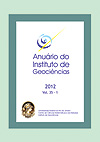Using values of tourism geosites Seven Cities (PI)
DOI:
https://doi.org/10.11137/2012_1_209_221Abstract
The National Park of Seven City (PN7C) was indicated by the Geological Survey of Brazil (CPRM), Geoparks under the Project in Brazil, as a potential area to create a Geopark because of the relevance of its geomorphological scenic beauty and paleoenvironmental. For the geotourism be promoted on this site, it is necessary advanced the adoption of measures geoconservation and beginning with the assessment of the geological heritage of the site visitation. In 2009, the CPRM started the report of the inventory of geological heritage PN7C, choosing eight Geosites, namely: Turtle Rock; Arc the Triomphe; Small Site; American Stone; Library; Lost City; and Canyons of Stone Waterfall the Riachão. In the measurement values are defined for Scientific Use; Conservation and Tourism, the latter being the main objective of this work establishing the potential of each geotouristic geosite from their values and Tourism of Use/Management, as defined in the first stage of the quantification. The highest values of tourist use, taking into account the overall average was 2.54, were assigned to Geosites Arc the Triomphe and Library, with values of 2, 8 and the lowest values for the Lost City Stone and Cannons, with 1,8 and 2,04, respectively. The cultural values of the Small Site and the Stone of the American are linked to the presence of archaeological graphics in sandstone cliffs that have not been dated. The Lost City, which was considered the seventh city of the park also features many graphics, but has no structure to the visitor and is open only for scientific research and the Stone of the American is vulnerable to visitors as they do not have the access control visitors. The methodology used in this study consisted of the literature review, field research for direct observation, photographic documentation and collection of points with the use of GPS for mapping the location of Geosites.Downloads
Download data is not yet available.
Downloads
Published
2012-06-01
How to Cite
Lopes, L. S. de O., Araújo, J. L. L. and Nascimento, M. A. L. do (2012) “Using values of tourism geosites Seven Cities (PI)”, Anuário do Instituto de Geociências. Rio de Janeiro, BR, 35(1), pp. 209–221. doi: 10.11137/2012_1_209_221.
Issue
Section
não definida
License
This journal is licensed under a Creative Commons — Attribution 4.0 International — CC BY 4.0, which permits use, distribution and reproduction in any medium, provided the original work is properly cited.















